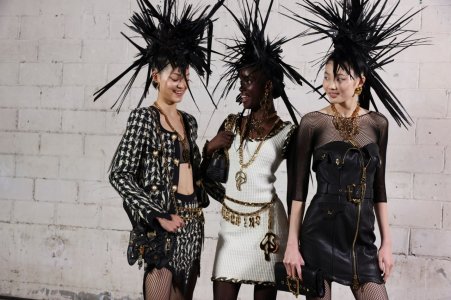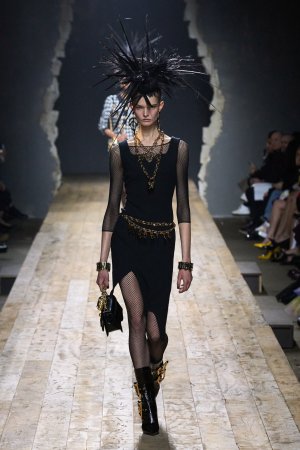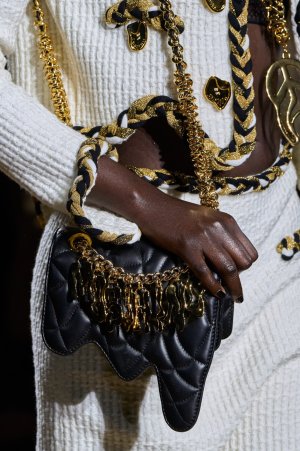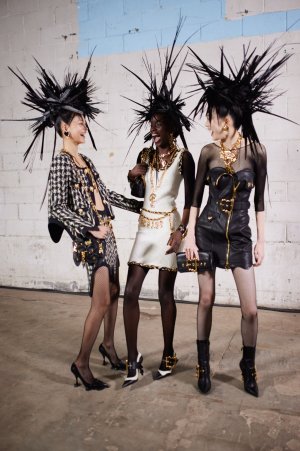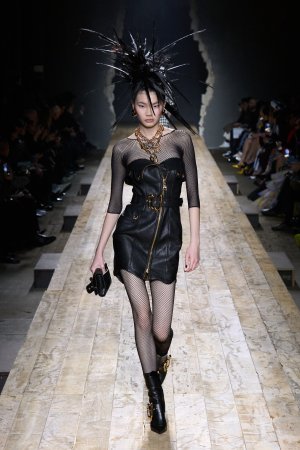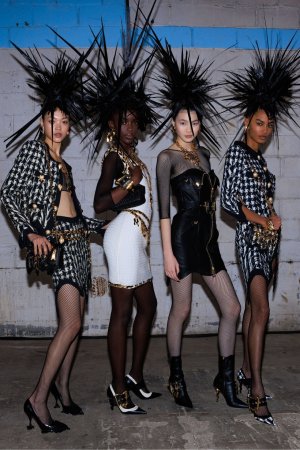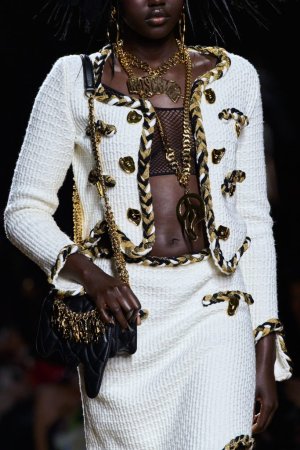You are using an out of date browser. It may not display this or other websites correctly.
You should upgrade or use an alternative browser.
You should upgrade or use an alternative browser.
Discussion: Who Should Be The Creative Director of Chanel?
- Thread starter LadyJunon
- Start date
LANZO_358
Active Member
- Joined
- Apr 8, 2006
- Messages
- 1,902
- Reaction score
- 98
these suits are far too snobby and elitist (as they should be, really) to appoint someone like jeremy scott, who helmed a fashion house with a history of creating known IMITATIONS and PARODIES of original chanel designs. he's also american. a brit would sooner go to chanel than someone like scott. the only american designer i could see doing chanel is marc but he's just... there. it's going to be a french-speaking designer, and it's going to be hedi. it's a natural fit, and he will usher in a period of ultra-exclusive, discreet luxury for the house. i know it, you know it, the entire world knows it lol
Not only the suits but I’d say some fans too - even those who can’t afford Chanel. Tbh, I blinked a little when I saw his name as a contender. JS at Chanel?! Y’all would trust his taste at Chanel?! Forget Moschino, no one remembers those gaudy adidas trainers with the gorilla?! He’ll always be that guy for me.
I won’t even get into Marc Jacobs either, who - outside of his hooked-on-phonics tote bags - has not been an opinion leader in years.
LadyJunon
Well-Known Member
- Joined
- Aug 17, 2020
- Messages
- 5,044
- Reaction score
- 12,104
I've seen a few people suggest Rousteing, but I don't see him leaving Balmain nor do I think it's a good idea. I see him staying there for another 20 to 30 years and building his own Lagerfeld-esque legacy there.
Olivier rouesting at balmain makes sense. He seems to have built a loyal clientele that I don’t think will move over to Chanel. He can do his little Chanel references at balmain and it makes sense.
I do not get the Hedi love and for Chanel. He is incredibly limited as a “designer” from his references to his silhouettes. He does not know how to do ease and takes himself too seriously. There’s no fantasy or even ugliness in his work. He is such a boring designer, let him consult or something if you must. lol
I think people are nostalgic for those early 2006 Karl collections like fall 2005, spring 2006 fall couture 2006 when Karl was in his Hedi bag but hedi is not capable of those even if Karl was somewhat inspired by hedi at Dior homme
Saint Laurent prefall 2016 was his best women’s collection and it’s still quite limited.
I do not get the Hedi love and for Chanel. He is incredibly limited as a “designer” from his references to his silhouettes. He does not know how to do ease and takes himself too seriously. There’s no fantasy or even ugliness in his work. He is such a boring designer, let him consult or something if you must. lol
I think people are nostalgic for those early 2006 Karl collections like fall 2005, spring 2006 fall couture 2006 when Karl was in his Hedi bag but hedi is not capable of those even if Karl was somewhat inspired by hedi at Dior homme
Saint Laurent prefall 2016 was his best women’s collection and it’s still quite limited.
Deleted member 116957
New/Inactive Member
- Joined
- Apr 4, 2009
- Messages
- 13,746
- Reaction score
- 15,824
I've gotta admit... Marc Jacobs, as a serious suggestion (i.e. not one of tFS' jokes), baffles me. Maybe if this was the mid-00s, but in 2024? Marc Jacobs?!? No.I won’t even get into Marc Jacobs either, who - outside of his hooked-on-phonics tote bags - has not been an opinion leader in years.
MulletProof
Well-Known Member
- Joined
- Apr 18, 2004
- Messages
- 28,896
- Reaction score
- 7,955
Yeah, there are different types of Marc Jacobs.. Marc Jacobs in 2024 is the definition of a has-been, he hasn't even been able to go down some Carolina Herrera route (steady and not innovative but still dignified and displaying confidence of his place in fashion), his shows reek of desperation, just full of gimmicks from beginning to end and he's not even good at it anymore. Even Rodarte looks more viable next to his brand and lord knows we thought that was money-laundering lol.I've gotta admit... Marc Jacobs, as a serious suggestion (i.e. not one of tFS' jokes), baffles me. Maybe if this was the mid-00s, but in 2024? Marc Jacobs?!? No.
Marc Jacobs peaked in 2001, Fall 2001 is incomparable to any of his work before and after, every look is perfect, elegant enough for LV and youthful enough for what he always expressed through his own label and especially his secondary line (Marc by Marc), and the result is actually very Chanel by Karl. The collections and campaigns that followed it for a couple of years are also pretty good and you can tell he had his finger on the pulse of an entire generation at the time, he knew how to tackle its sensibilities, no difficulty interpreting what was cool in both the world of luxury and on the streets and he could project it accurately and capture pop culture with ease. It's been 23 years since then and age does redirect curiosity and the ability to 'absorb' culture to more a complex/personal path so it's not going to happen. He's the worst choice for Chanel right now, you might as well keep Viard.
PDFSD
Well-Known Member
- Joined
- Mar 27, 2024
- Messages
- 2,930
- Reaction score
- 10,412
How Will Chanel Pick a New Designer?
Following the departure of artistic director Virginie Viard, the French couture and beauty giant will need a new creative leader — or leaders — to bring fresh energy to its cross-category pyramid of products.Late Wednesday, BoF broke the news that Virginie Viard had exited Chanel. (Getty Images)
By ROBERT WILLIAMS
07 June 2024
BoF PROFESSIONAL
A force for continuity who carried on Karl Lagerfeld’s legacy after his 2019 death, while bringing a lighter, more youthful touch to Chanel’s runway collections, Viard sat atop a storied fashion empire. The second-biggest luxury brand with revenues of nearly $20 billion last year, Chanel stages six fashion shows per year across ready-to-wear, haute couture and its annual “Métiers d’Art” craftsmanship showcase, not to mention its near-unparalleled brand prestige.
While some fashion fans bristled at Viard’s increased focus on ultra-wearable silhouettes, her more approachable, contemporary take on flagship products like tweed jackets helped to fuel surging sales as the Covid-19 pandemic pushed luxury consumers toward blue-chip brands. During her tenure, sales of ready-to-wear increased by a factor of 2.5, Chanel recently reported. That’s to say, her successor will have big shoes to fill.
At the same time, Chanel is currently in such a strong position that the house won’t need to rush Viard’s succession. The brand grew by 16 percent in 2023, outpacing key rivals, and has such clear codes and sufficient clout with consumers to weather a season or two without a creative director. (Chanel will rely on its studio team to designer its June couture outing).
Yet even if Chanel can afford to take its time, the fashion world is breathlessly awaiting news on who will take up the industry’s most coveted position. Speculation as to who will succeed Viard went into overdrive as soon as her exit was reported, with names circulating on social media ranging from more long-rumoured contenders like Hedi Slimane to outliers like ex-Moschino creative director Jeremy Scott.
Much will depend on how Chanel and its owners, the Wertheimer brothers, see the creative director role going forward. Do they want a transformational figure like Lagerfeld, who could revamp the brand’s image and serve as the face of the house for decades? Or another deft merchandiser like Viard who will get the most commercial mileage out of its craftspeople and codes? New configurations are also possible, with Chanel eventually choosing to employ multiple creative directors like Hermès or Louis Vuitton.
The Big One
Rumours have swirled that Hedi Slimane was being lined up to join Chanel, and launch menswear, since his 2016 departure from Saint Laurent. Now, after a 5-year turn at Celine that saw the house grow into a €2.5 billion per year megabrand, sources say the designer has been engaged in a lengthy, difficult negotiation with parent company LVMH that could lead to his departure. And Chanel speculation has gone into overdrive again.In some ways, Slimane seems like the perfect fit for Chanel. A branding genius and impeccable stylist, his penchants for black-and-white, bold-face branding and practice of shooting campaigns himself are heavily inspired by Karl Lagerfeld’s Chanel. And while Lagerfeld rarely shied away from doling out brutal criticism, he habitually made glowing remarks about Slimane, as well as adopting the designer’s ultra-slim menswear silhouette.
But bringing on the exacting (and reclusive) Slimane would come with challenges: The designer is known for demanding total control over branding, campaigns, store concepts and more. While that approach helps to curate an ultra-coherent universe for devotees of his vision, giving that much power to one individual would be risky for a company at Chanel’s scale. It also feels out of step with new CEO Leena Nair’s mission to evolve Chanel’s internal culture, professionalise processes and reinforce teams and structures in a bid to future-proof the luxury giant.
Then there’s Slimane’s approach to design: composing the latest versions of his trademark slim silhouette by reinterpreting vintage references, or demanding that teams bring him myriad fully-realised samples to “shop” from (and cancelling the rest). This would be out of step with Chanel’s couture culture, where designers work closely with the atelier and suppliers to bring collections to life.
Slimane also doesn’t engage with the press or do public appearances. Neither did Viard, for that matter. But predecessor Lagerfeld’s charismatic public persona was an asset as he built up Chanel’s aura of high-flying fabulosity over more than 30 years.
Free Agents
Then, there’s the handful of major design talents who currently don’t have a brand.Sarah Burton exited Alexander McQueen last fall 13 years after taking the reins following founder Lee McQueen’s death. She managed to synthesise McQueen’s founding notions like Britishness, naturalia and punk in collections that were more romantic and approachable and less dark (albeit also less exciting). She’s known to be a collaborative, inclusive designer who has made perpetuating savoir-faire a priority at McQueen — in terms of culture, she’s a fit for the company Chanel says it wants to be. Lagerfeld was a fan, too: “She is fantastic and what she’s doing at McQueen is truly haute couture,” he said in 2016.
Pierpaolo Piccioli is another free agent, having left Valentino in March. The bombastic romance of Piccioli’s haute couture for Valentino wasn’t every fashion critic’s cup of tea, but his shows featured authority, confidence and calculated risk in a way that’s been missing from Chanel’s runway under Viard. In ready-to-wear, shoes and bags, however, Piccioli’s ideas were less easily translated to hit products.
Wild Cards
A collision of Phoebe Philo’s intellectual, design-forward aesthetic with Chanel’s codes is a long-shot possibility some fashion fans are clamouring to see. But there’s an enormous gap between the scale and complexity of her previous roles and Chanel (Celine topped out at around €1 billion during her tenure, and did not yet include menswear or beauty).Chanel may be a $20 billion per-year powerhouse, but it starts every year at zero like as everyone else. In order to keep powering a business at this scale, a designer with a proven commercial track record like Dior’s Maria Grazia Chiuri would be a serious contender.
Chiuri’s approach to fashion — which involves animating digestible design ideas with varied collaborations and storytelling focused on craftsmanship — has fuelled rapid growth at Dior, and her way of working would certainly be applicable at principal rival Chanel.
New Configurations
Chanel could also opt for a new configuration that makes room for multiple designers, like at Louis Vuitton, Hermès and Dior. Bringing on Slimane wouldn’t be the only option if the company decided to push into menswear: the brand might seek out an adaptable menswear star, like Dior’s Kim Jones to head up the expansion, while hiring another designer to handle women’s.As the brand increasingly seeks to position itself as a house of “absolute luxury” — a purveyor of timeless investment pieces à la Hermès — it could also look to bring on a womenswear designer (or designers) who have managed to thrive under a more collaborative structure with multiple voices. Hermès’ creative director for women’s ready-to-wear Nadège Vanhee-Cybulski is one name the internet hasn’t yet thought up.
Such a setup would allow for additional perspectives and storytelling opportunities, while also ensuring that no one person is ever bigger than the brand.
imjustken
Well-Known Member
- Joined
- Apr 28, 2024
- Messages
- 242
- Reaction score
- 673
Love Nadège at Hermès. She's the designer whose clothes I love the most these days. But I want her to stay at Hermès. She's doing too good of a work there.Hermès’ creative director for women’s ready-to-wear Nadège Vanhee-Cybulski is one name the internet hasn’t yet thought up.
FashionFanatico
I really don’t care. Do U?
- Joined
- Jun 5, 2011
- Messages
- 1,736
- Reaction score
- 2,536
^ what baffles me the most of her sudden departure is that all the so called fashion insiders (aka BOF, WWD, Vogue, Vanessa Friedman, Stylenotcom etc. etc.) had ZERO clue that this could happen. Only Maciavelli Mary aka Cathy Horyn writes in her analysis for the Cut that she KNEW FOR SURE (but never said anything) after the latest praise for VV from Nair that it was clear the axe for VV was near... lol
And now after i read this BOF article - the same again: ZERO facts, just speculations a gogo and looking into a with big tacky CC's and Camlias embellished crystal ball. Even here on TFS there is much more back story to it and much more deeper, intense, creative (and much more fun) conversations.
I feel all these fashun insiders are not worth the money anymore - they have not connections to the top and not even to the bottom of the real industry. Otherwise they would come up with different names as successors - and not the usual suspects as Burton, Piccioli (it will never happen), Philo (why?), Chiuri (hell no!), Jones (Hell of a Hell no!) or even the boring woman from Hermès. And of course Hedi, which is a safe bet anyway. But otherwise? Don't they know any In-House-Designers? I want to know who was the left hand of Virginie the last 5 years. But nothing. just a lot of text without any real news. dissapointing.
I would never pay for a membership for that hot air. BOF you are just a bluff...
And now after i read this BOF article - the same again: ZERO facts, just speculations a gogo and looking into a with big tacky CC's and Camlias embellished crystal ball. Even here on TFS there is much more back story to it and much more deeper, intense, creative (and much more fun) conversations.
I feel all these fashun insiders are not worth the money anymore - they have not connections to the top and not even to the bottom of the real industry. Otherwise they would come up with different names as successors - and not the usual suspects as Burton, Piccioli (it will never happen), Philo (why?), Chiuri (hell no!), Jones (Hell of a Hell no!) or even the boring woman from Hermès. And of course Hedi, which is a safe bet anyway. But otherwise? Don't they know any In-House-Designers? I want to know who was the left hand of Virginie the last 5 years. But nothing. just a lot of text without any real news. dissapointing.
I would never pay for a membership for that hot air. BOF you are just a bluff...
Last edited by a moderator:
FashionFanatico
I really don’t care. Do U?
- Joined
- Jun 5, 2011
- Messages
- 1,736
- Reaction score
- 2,536
Love Nadège at Hermès. She's the designer whose clothes I love the most these days. But I want her to stay at Hermès. She's doing too good of a work there.
gallianostan
Well-Known Member
- Joined
- Sep 7, 2021
- Messages
- 1,146
- Reaction score
- 3,799
A collision of Phoebe Philo’s intellectual, design-forward aesthetic with Chanel’s codes is a long-shot possibility some fashion fans are clamouring to see.
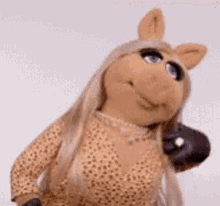
TerraVera
Well-Known Member
- Joined
- Dec 23, 2023
- Messages
- 205
- Reaction score
- 334
^ what baffles me the most of her sudden departure is that all the so called fashion insiders (aka BOF, WWD, Vogue, Vanessa Friedman, Stylenotcom etc. etc.) had ZERO clue that this could happen. Only Maciavelli Mary aka Cathy Horyn writes in her analysis for the Cut that she KNEW FOR SURE (but never said anything) after the latest praise for VV from Nair that it was clear the axe for VV was near... lol
And now after i read this BOF article - the same again: ZERO facts, just speculations a gogo and looking into a with big tacky CC's and Camlias embellished crystal ball. Even here on TFS there is much more back story to it and much more deeper, intense, creative (and much more fun) conversations.
I feel all these fashun insiders are not worth the money anymore - they have not connections to the top and not even to the bottom of the real industry. Otherwise they would come up with different names as successors - and not the usual suspects as Burton, Piccioli (it will never happen), Philo (why?), Chiuri (hell no!), Jones (Hell of a Hell no!) or even the boring woman from Hermès. And of course Hedi, which is a safe bet anyway. But otherwise? Don't they know any In-House-Designers? I want to know who was the left hand of Virginie the last 5 years. But nothing. just a lot of text without any real news. dissapointing.
I would never pay for a membership for that hot air. BOF you are just a bluff...
i think what plays into that - the mum's the word of it all - is nowadays fashion publications and media are so dependent on advertisers aka the same brands they are carefully speculating about that they'd rather not rock the boat and post gossip or rumors before the brand itself has made a public announcement.
yet, if any of them heard whispers of what was to come, that would've been valuable content. heck a comprehensive deep dive into chanel would have provided more interesting news and information than aftermath "i knew it"'s and "i had an inklings"'s puffs of smoke they're serving us. y'all are late and didn't really know like the rest of us. no need to put on airs about being clued in weeks ago about VV's abrupt dismissal.
highkey this is why miss tweed has her place. she's independent enough to post gossip and rumor without backlash, but at the end of the day, these platforms might need to have better finesse and backbone to do the same albeit in not such an overt, direct way.
as for cathy, i used to share her opinion, but within the last five or so years those opinions have been very questionable, if not perplexing. she's in the same boat as some of these other fashion critics, weak ones included, whose opinion has become more irrelevant and sycophantic than objective, thoughtful, and nuanced. in other words, people are compromised because they don't want to lose favor with a house, when their refreshing honesty is what put them on the map in the first place. an ironic decline of their waning authority.
Also for anyone suggesting Jacquemus lolsomeone in this thread actually suggested harris reed. some of you really need your tfs privileges revoked
Creative
Well-Known Member
- Joined
- Oct 1, 2007
- Messages
- 5,765
- Reaction score
- 5,727
Lol, I think you are right, I have in mind his mid 00 collections, but he’s a meme now.I've gotta admit... Marc Jacobs, as a serious suggestion (i.e. not one of tFS' jokes), baffles me. Maybe if this was the mid-00s, but in 2024? Marc Jacobs?!? No.
Maybe he’s just being a meme because he needs attention, and maybe with a house like Chanel he could bring his coolness back, IDK.
Edith: I should also say that I believe in the 10 years relevancy. He already had it and he won’t have it back probably.
Aging is hard when you are a designer.
LadyJunon
Well-Known Member
- Joined
- Aug 17, 2020
- Messages
- 5,044
- Reaction score
- 12,104
The fact that this was his last collection for Moschino too. So few designers are able to end their tenures on such a high note like Jeremy did.I'll just keep on campaigning for Jeremy
View attachment 1276641
View attachment 1276642
View attachment 1276643
View attachment 1276644
View attachment 1276645
View attachment 1276646
View attachment 1276647
She is way to boring… Hermes needs a change
Similar Threads
- Replies
- 193
- Views
- 20K
- Replies
- 726
- Views
- 57K
- Replies
- 241
- Views
- 94K
Users who are viewing this thread
Total: 3 (members: 0, guests: 3)
New Posts
-
-
Jonathan Anderson - Designer, Creative Director of JW Anderson & Christian Dior (10 Viewers)
- Latest: Lola701
-
-
-

